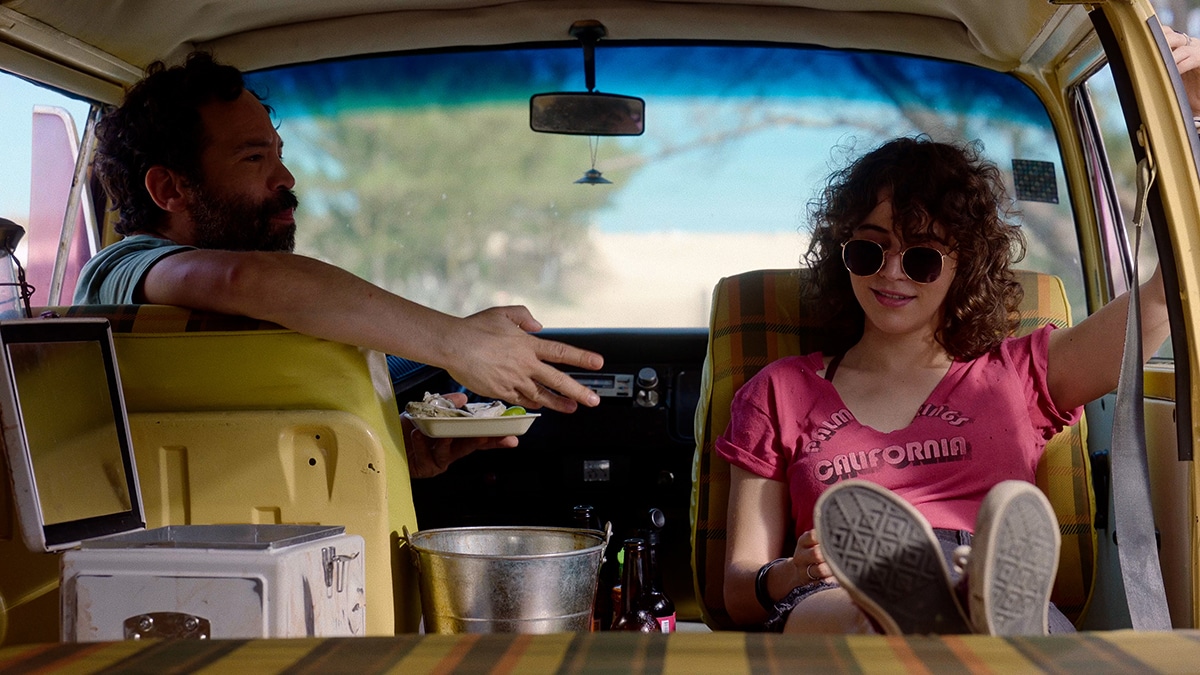Café Chairel starts off slow, like a fresh pot of coffee on a sunny Sunday morning overlooking one of the many lagoons that surround Tampico, México, where the film is set (and also, my beloved, and at times hated, hometown). The first few minutes feel like life here: relaxed (some might call it boring, but they just don’t know better) with a prevalent feeling that nothing happens and nothing ever changes. However, a deeper story is always developing in those blink-and-you’ll-miss-them moments of stillness.
It’s in these first few minutes that we meet Alfonso, a man as sweet as cream, (played by Mauricio Isaac) and Katia, a young woman who is as bitter as dark coffee (Tessa Ía). They’re two strangers whose lives are plagued by loss and loneliness, and whose stories are unexpectedly intertwined. When their paths cross, they find refuge in each other and in the struggle of trying to run a coffee shop, Café Chairel (named after a local lagoon) despite not knowing a thing about business or coffee. The film moves back and forth in time, featuring flashbacks from both Alfonso’s and Katia’s seemingly happier pasts. In the present, though, both of them seem suspended in time, trapped in a limbo thanks to the haunting quality of those happier memories and the regret that comes with them.
Somewhere between sacks of coffee beans, oysters, shrimp cup noodles, and beach raccoons, both of our main characters gradually let go of their past and begin focusing on building a comfortable and happy present.
The stillness is evident in the film’s slow, relaxed pace and the way frames are set. According to director Fernando Barreda Luna, “The shots are static. There’s rarely any movement from the cameras. It’s the actors who get to use movement – in and out of shots, farther or closer to the cameras – to tell the story.”
While the movie is set in Tampico, the story is very much a universal one. “Coffee is a pretty universal thing. It’s part of millions of people’s morning routines. It helps people wake up and connect, two things that we wanted to show on the film,” is how Barreda Luna puts it, “We wanted to showcase Tampico in a nostalgic way, not in the typical touristy way that it’s usually portrayed in. At the same time, we didn’t want it to be too on-the-nose.” Café Chairel is filled with hyper-specific references, like the birds and the sounds of the train, that Jaibos (as Tampiqueños lovingly call ourselves) will recognize as part of our stories. These elements also allow those who have never visited the city a chance to experience it authentically, away from stereotypes.
It gives a local’s sense of the place. As the film takes you through the places of Katia’s love and heartbreak, I remembered my own romantic histories, those moments that will forever live in the nooks and crannies of las Escolleras, stuck between each grain of sand at Miramar, and woven on the raffia chairs at Degas Café. As Katia reminisced, so did I. As she healed, so did a little bit of my heart.
Café Chairel is director Barreda Luna’s second film, one of many in which he’s worked with his producer and wife, Jessica Villegas. For them, the film holds a special personal meaning, “We knew we wanted to make a film centered in the place where we were born, grew up in, and fell in love. For me, personally, it has an extra layer of significance, since all four of my grandparents are in it, in one way or another,” Villegas noted.
An old, 1921, Dutch-style, Canadian pine house built during the city’s oil boom serves as the main setting for the film, giving the whole thing the feeling of sentimentality. “This is the heart of the film. The house is almost like another main character. I found it almost by accident during location scouting… Luckily, everyone knows each other in Tampico, so we quickly got the owners to graciously give us a tour,” Barreda shares. “It was in such a state of abandonment and decay that we had to renovate and repair it to avoid any potential risks to the cast and crew. Since it’s such an iconic part of the city, we had to make sure our renovations preserved the house’s original look.”
Growing up in Tampico, life felt slow and, yes, boring – There wasn’t much to do around here back then. I remember lovingly calling it “un rancho,” as it felt small and crowded. One of the few things I could do, though, was go to the movies. I’d meet my friends at Cinepolis on Hidalgo Ave. so we could gossip a bit as we waited in line to buy our tickets. I loved watching other people’s stories unfold on a big screen, transporting me to different places and realities that seemed so foreign at the time. Although I resented the fact that my sometimes unamusing city never made it the big screen. Unless you count the 1948 Oscar-winning film, Treasure of the Sierra Madre, that was set and filmed here (a fact that tour guides downtown won’t let anyone forget).
“It’s such an honor getting to take a little piece of our hometown’s story and essence out into the world,” Villegas shared. It took over seventy years for another film set in Tampico to come along, and what a film it is.
Café Chairel will begin its festival run at the Sonoma International Film Festival. While theatrical release is part of their long-term plan for the movie, Barreda and Villegas want to give it its fair shot on the festival circuit. At SIFF, it is one of eight films being shown, and the only one doing a premiere.

